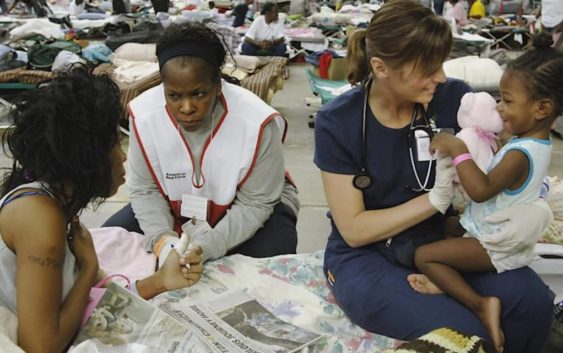- Recovery continues for western NC nearly two months after Hurricane Helene
- Recovery continues for western NC nearly three months after Hurricane Helene
- Cast of Scandal reunites to show support for western North Carolina after Hurricane Helene
- Tropical Storm Sara threatens to bring flash floods and mudslides to Central America
- Hurricane-stricken Tampa Bay Rays to play 2025 season at Yankees' spring training field in Tampa
Houston residents, former mayor reflect on Hurricane Katrina response 17 years later

More than 200,000 evacuees came to Houston shortly before and immediately after the storm and thousands chose to make the city their permanent home.
HOUSTON — The music stopped 17 years ago this week.
Hurricane Katrina brought devastation and death to New Orleans. More than 1,800 people died.
Hundreds of thousands of evacuees sought refuge in Houston in the aftermath and many of them decided to make the city their permanent home.
Their addition would forever change the face of Houston.
It’s estimated that more than 200,000 evacuees came to Houston just before and immediately after the storm.
Thousands were first brought to the Astrodome and the George R. Brown Convention Center when there wasn’t any other place to go.
About a one-minute drive from the Astrodome, the kitchen at Sleepy’s Poboys is busy.
“I lost everything,” co-owner Nicole Washington said. “I mean nothing, nothing (left).”
Rene and Nicole Washington were living in New Orleans when Katrina hit. Rene said he took a job with the Army Corps heading a clean-up crew after the storm.
“I had to inspect the buildings and everything before they’d go in,” Rene Washington said. “And we found dead kids, we found a lot of bodies.”
Eventually, the couple would follow the path of others who’d decided to start new lives in Houston and they’ve never looked back.
“When the levees broke and the town, the metropolitan area, became uninhabitable, what was the closest big city?” former Houston Mayor Bill White said.
White was often the face of the local effort to help the victims of Hurricane Katrina.
“Our task was just: How do we treat our neighbors the way we would want to be treated in a similar situation?” White said.
Without a similar natural disaster to use as a reference point, White has been credited with helping craft a roadmap for other American cities when they’re called upon to be safe harbors.
“The FEMA program was to put people in trailers and tents, they even spent half a billion dollars on a cruise ship,” White said. “But I thought people would need to get on with their lives. We’ll provide an apartment near a transit site, we expect people to get to their jobs, put their kids in school and abide by our laws. That was the trade that we made.”
White said the plan was ultimately a success.
The former mayor said Houston’s effort to help the victims was perhaps best articulated by an elderly woman at a church in Sunnyside who told him this soon after the storm:
“[She said] the people of Houston, from all walks of life, of all races, taking people into their home, feeding them, volunteering, I thought, ‘You know, this burden of racism that I thought would be there forever, it’s withering away.’”